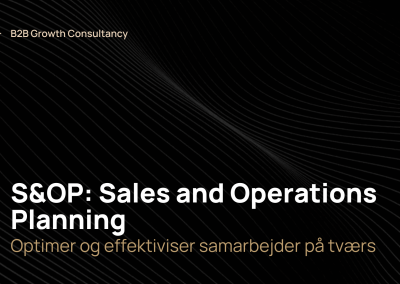The customer journey , also known as the customer journey, is an important understanding for the success of your B2B marketing and entire inbound strategy. In this article, we will review the importance of the customer journey and how it can help your business create an exceptional customer experience and get you more leads.
- What is the customer journey?
- How can we help you with your customer journey?
- Example of a practical customer journey where you can execute?
- Benefits of understanding the customer journey
- How to map a customer journey
What is the customer journey?
The customer journey is an essential factor in the success of any business as it maps the customer’s interaction with the company from initial interest to final purchase decision. By understanding and optimizing this process, businesses can better meet customer needs and create exceptional customer experiences.
The customer journey consists of different stages, typically divided into:
- Attraction
- Interest
- Decision
- Evaluation
There are different approaches to what you should do, pay attention to and what your potential customers find interesting at the different stages. Below we have created a graphic to show this.
The customer journey is a model you should work with if you work with marketing, sales, product or customer service on a daily basis. It’s crucial to know what process your potential customers go through before they end up with you. It gives an insight into their problems, needs and what is important to them in their work.

How can we help you with your customer journey?
Looking for knowledge on how to map your customer journey, or googling around to learn more about customer journeys – we can help you. At Radiant, we help companies understand their customer journey and how to practically map it every day. We have more than 6 years of experience in mapping customer journeys and how to use them in practice for B2B sales and in your CRM system. Some of the tasks we help with are:
- Understand the customer journey
- Use customer journeys in the sales process
- Customer journeys at the heart of marketing funnels
Example of a practical customer journey where you can execute?
The customer journey consists of multiple touchpoints , also known as toucpoints in English. Imagine a company selling an HR SaaS solution to businesses – they can influence the customer journey through lead nurturing:
First toucpoints: HR manager searches on ‘Talent management platform’ here the company has written a blog post that the lead reads
Second touchpoint: The HR manager is now enrolled in the company’s retargeting on LinkedIn, Meta and Google and therefore receives ads.
Third toucpoint: The company uses lead scoring so B2B salespeople are notified to contact the HR manager when the lead scoring says the lead is hot enough. Here, the lead is expected to visit websites (based on other touchpoints), open emails, etc.
Read more about lead nurturing
What is the digital customer journey?
The digital customer journey is all about how your customer interacts with your business online. This can include everything from the first time a potential customer finds you online through SEO.
With increasing digitalization and technological advancements, the customer journey has undergone a digital transformation. Customers are now able to gather and compare information about products and services online before making their purchase decision.
Instead of experiencing a linear path, the modern customer journey is more complex and crosses multiple digital channels. This requires a thorough understanding from businesses to deliver a seamless and personalized customer experience.
Read more about the “salesfunnel“
Use of the product/service
The key to improving the customer experience lies in your company’s ability to constantly adapt and refine the product or service based on customer feedback. This helps you rectify any issues and improve the areas that increase customer satisfaction. It’s important to know what type of customer you’re targeting.
Understanding the role of your product or service in the customer journey is essential to the success of your business. This not only gives you insight into how your customers interact with your product, but also which aspects of it are most valuable to them.
Benefits of understanding the customer journey
Incorporating the customer journey into your sales strategy is vital as it allows you to immerse yourself in your customers’ experience, understand their needs and thus personalize your services or products to them. This thorough understanding increases both customer satisfaction and loyalty.
By understanding and improving the customer journey, you can hone your marketing, drive sales and increase lead generation. This insight allows you to meet your customers at their specific level in the sales process and offer them solutions that are customized to their unique needs.
Understand your customers’ journey
An effective way to understand your customers’ journey is to use customer feedback. This provides in-depth insights into their experiences, preferences and challenges that can help you refine and improve your customer experience.
Using advanced analytics and data collection techniques is also crucial. These methods can help you track your customers’ behavior, understand their preferences and identify which parts of the customer journey create the most challenges or successes for your customers.
Plan marketing and sales
Understanding the customer journey can be a great tool for strategic marketing and sales planning. It helps focus efforts where they have the greatest impact on the customer.
Incorporating the customer journey into your sales and marketing strategy is crucial for success. It provides insights into which touchpoints are most valuable to customers and helps optimize conversion and retention.
More leads
Using the customer journey as a tool to generate more leads can be extremely effective. With a deep understanding of customer buying behavior, sales processes can be optimized to capture them at the right moment. Similarly, mapping the customer journey can help define which channels you should be active on in relation to your inbound strategy.
What’s more, focusing on the customer journey can make the most of your marketing strategy and generate more leads. After mapping and understanding the customer journey, the company can appropriately time its marketing efforts to optimize lead generation.
Read a guide with 6 tips to get more leads
How to map a customer journey
A step-by-step guide can be surprisingly effective for mapping your customer journey. This planned approach actively supports the understanding of customer interactions with your business and promotes more effective marketing and sales planning.
Exploring customer journey mapping techniques and methods is essential for turning insights into action. The tool used can vary, but the important thing is that the process results in a clear, actionable customer journey that provides valuable guidance to your teams.
Customer journey models
In the customer journey models section, we pick out a number of popular approaches to illustrate customer journeys and assess their potential applicability to your business.
- AIDA Model: Traditional marketing model that breaks down the customer journey into four steps: Discovery, Interest, Desire and Action.
- Customer Journey Map: A detailed visual overview of the customer’s interactions with your business, from first contact to eventual conversion into a loyal customer.
- Sales Funnel: A model that shows how potential customers move through a sequence of steps from initial discovery to purchase.
- Buyer’s Journey: A three-step model (Discovery, Consideration, Decision) that focuses on the customer’s information gathering and decision-making process.
- Touchpoint Analysis: Focuses on identifying and optimizing customer interactions with your business during their journey.
Why do we know about the customer journey?
At Radiant, we have a purpose to grow B2B companies. We have a few different methods for this, including sales execution, which we call Sales as a Service, then we optimize HubSpot, which we call HubSpot as a Service.
Working with customer travel is a natural part of this work, which is why we also help our customers with it.
We had a great workshop with Radiant where we had a dialog about customer journeys and touch-points, which was the starting point for establishing our lead scoring and giving us insights that we could translate into focus areas.Jensen, M.R
The above is a quote from one of our customers talking about our work with customer journeys. If you would like help with HubSpot or sales – please do not hesitate to contact us – we are happy to give you a non-binding introduction to whether we can help you.



